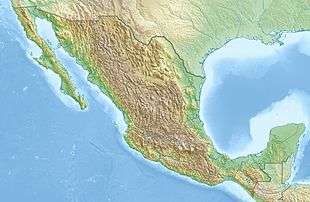1995 Colima–Jalisco earthquake
 | |
| Date | October 9, 1995 |
|---|---|
| Origin time | 15:35:56 [1] |
| Magnitude | 8.0 Mw |
| Depth | 40 km (25 mi) [1] |
| Epicenter | 19°05′N 104°11′W / 19.08°N 104.18°WCoordinates: 19°05′N 104°11′W / 19.08°N 104.18°W [1] |
| Areas affected | Mexico |
| Max. intensity | VIII (Severe) [2] |
| Tsunami | Yes |
| Casualties |
49–58 dead [3] 100 injured [3] |
The 1995 Colima–Jalisco earthquake occurred on October 9 at 15:35 UTC with a moment magnitude of 8.0 and a maximum Mercalli intensity of VIII (Severe). The shock occurred off the coast of Jalisco, Mexico, where a tsunami was triggered that affected a 200 km (120 mi) stretch of the coast.[4] The earthquake could be felt in Mexico City and in high-rise buildings in Dallas and Houston.[5] In Mexico, the Cihuatlan-Manzanillo was the most severely affected area. At least 49 people died and 100 were injured.
Tectonic setting
This earthquake occurred in the area where the Rivera Plate subducts beneath the North American Plate.[6] It was the result of the relative movements between the North American Plate, the Rivera Plate, and the Cocos Plate.[7]
Damage
Although the tsunami affected a 200 km stretch of coast, severe damage was confined to areas with shallow shoreline topography. Most of the flooding occurred in the Tenacatita Bay area.[4] Landslides blocked roads between Guadalajara and Manzanillo.[5] In Manzanillo, 18 people died in the collapse of an eight-story hotel.[8]
Characteristics
Earthquake
The earthquake rupture lasted for about a minute and involved a 200 km long break along the plate boundary.[6] The greatest displacement of the fault is about 5m.[9] A 14 cm subsidence occurred at Manzanillo.[4]
The variations in observed seismic intensity indicate that three asperities were ruptured during this event.[6]
Tsunami
The tsunami had a maximum run-up height of 5.1 m. There were at least two waves recorded. The tsunami was also observed in Ecuador, French Polynesia, Samoan Islands, Australia and Hawaii.[4]
Postseismic moment release
Postseismic deformation has been recorded after the main shock. If the postseismic moment release up to about two weeks after the main shock is included, it will be equivalent to 35% of that of the main shock, which will make the additional seismic moment equivalent to that of an Mw 7.7 earthquake.[10]
See also
References
- 1 2 3 ISC (19 January 2015), ISC-GEM Global Instrumental Earthquake Catalogue (1900–2009), Version 2.0, International Seismological Centre
- ↑ USGS (December 1, 2008), EXPO-CAT Earthquake Catalog, Version 2007-12, United States Geological Survey
- 1 2 USGS (September 4, 2009), PAGER-CAT Earthquake Catalog, Version 2008_06.1, United States Geological Survey
- 1 2 3 4 NGDC. "Comments for this tsunami event". Retrieved 13 March 2010.
- 1 2 USGS. "Significant earthquakes of the World, 1995". Retrieved 13 March 2010.
- 1 2 3 Zobin, V.M.; Ventura-Ramirez J.F. (1998). "The macroseismic field generated by the Mw 8.0 Jalisco, Mexico, earthquake of 9 October 1995". Bulletin of the Seismological Society of America. 88 (3): 703–711. Retrieved 2010-03-13.
- ↑ http://www.ceprode.org.sv/staticpages/pdf/spa/doc11859/doc11859-b.pdf
- ↑ New York Times News Service (January 23, 2003). "Death toll rising after earthquake in Mexico". The Baltimore Sun. Retrieved 2011-12-20.
- ↑ http://www.usc.edu/dept/tsunamis/manzanillo/
- ↑ http://www.geodesy.cwu.edu/about/pubs/melbourne/Melbourne_WebbEA_Postseis.pdf